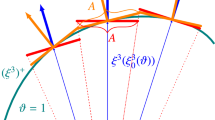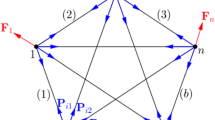Abstract
In this paper, an efficient method is developed for the formation of null bases of four-node quadrilateral plate bending finite element models, corresponding to highly sparse and banded flexibility matrices. This is achieved by introducing a new four-node quadrilateral plate bending element, and using special graphs associated with the finite element models. The results are compared to those of the previously developed graph theoretical and algebraic force methods, and also the displacement approach.
Similar content being viewed by others
References
Henderson J.C., de C.: Topological aspects of structural analysis. Aircr. Eng. 32, 137–141 (1960)
Maunder, E.A.W.: Topological and linear analysis of skeletal structures. Ph.D. Thesis, London University, Imperial College (1971)
Henderson J.C., de C., Maunder E.A.W.: A problem in applied topology. J. Inst. Math. Appl. 5, 254–269 (1969)
Kaveh, A.: Application of topology and matroid theory to the analysis of structures, Ph.D. Thesis, London University, Imperial College (1974)
Kaveh A.: Improved cycle bases for the flexibility analysis of structures. Comput. Methods Appl. Mech. Eng. 9, 267–272 (1976)
Kaveh A.: A combinatorial optimization problem; optimal generalized cycle bases. Comput. Methods Appl. Mech. Eng. 20, 39–52 (1979)
Cassell A.C.: An alternative method for finite element analysis: a combinatorial approach to the flexibility method. Proc. R. Soc. Lond. A 352, 73–89 (1976)
Denke, P.H.: A general digital computer analysis of statically indeterminate structures, NASA-TD-D-1666 (1962)
Robinson J.: Integrated Theory of Finite Element Methods. Wiley, NY (1973)
Topçu, A.: A contribution to the systematic analysis of finite element structures using the force method (in German), Doctoral Dissertation, Essen University (1979)
Kaneko I., Lawo M., Thierauf G.: On computational procedures for the force methods. Int. J. Numer. Methods Eng. 18, 1469–1495 (1982)
Soyer E., Topçu A.: Sparse self-stress matrices for the finite element force method. Int. J. Numer. Methods Eng. 50, 2175–2194 (2001)
Gilbert J.R., Heath M.T.: Computing a sparse basis for the null space. SIAM J. Alg. Dis. Meth. 8, 446–459 (1987)
Coleman T.F., Pothen A.: The null space problem I: complexity. SIAM J. Alg. Dis. Meth. 7(4), 527–537 (1986)
Coleman T.F., Pothen A.: The null space problem II: algorithms. SIAM J. Alg. Dis. Meth. 8(4), 544–561 (1987)
Pothen A.: Sparse null basis computation in structural optimization. Numerische Mathematik 55, 501–519 (1989)
Patnaik S.N.: Integrated force method versus the standard force method. Comput. Struct. 22, 151–164 (1986)
Patnaik S.N.: The variational formulation of the integrated force method. AIAA J. 24, 129–137 (1986)
Kaveh A., Koohestani K., Taghizadieh N.: Efficient finite element analysis by graph-theoretical force method. Finite Elem. Anal. Des. 43, 543–554 (2007)
Kaveh A., Koohestani K.: Efficient finite element analysis by graph-theoretical force method: triangular and rectangular plate bending elements. Finite Elem. Anal. Des. 44, 646–654 (2008)
Kaveh A., Koohestani K.: Efficient graph-theoretical force method for three dimensional finite element analysis. Commun. Numer Methods Eng. 24, 1533–1551 (2008)
Kaveh, A., Naseri Nasab, E.: A new triangular plane stress and plane strain element for sparse and banded flexibility matrices via force method. Finite Elem. Anal. Des. (2009)
Kaveh A.: Optimal Structural Analysis, 2nd edn. Wiley, Somerset (2006)
Kaveh A., Roosta G.R.: Comparative study of finite element nodal ordering methods. Struct. Eng. 20(1–2), 86–96 (1998)
Kaveh A.: Structural Mechanics: Graph and Matrix Methods, 3rd edn. Research Studies Press, Somerset (2004)
Kaveh A., Koohestani K., Taghizadieh N.: Force method for finite element models with indeterminate support conditions. Asian J. Civil Eng. 8, 403–417 (2007)
Author information
Authors and Affiliations
Corresponding author
Rights and permissions
About this article
Cite this article
Kaveh, A., Nasab, E.N. A new four-node quadrilateral plate bending element for highly sparse and banded flexibility matrices. Acta Mech 209, 295–309 (2010). https://doi.org/10.1007/s00707-009-0180-5
Received:
Revised:
Published:
Issue Date:
DOI: https://doi.org/10.1007/s00707-009-0180-5




